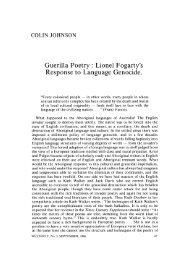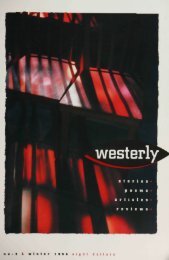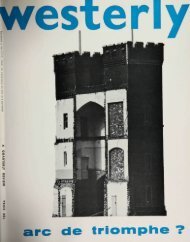Create successful ePaper yourself
Turn your PDF publications into a flip-book with our unique Google optimized e-Paper software.
clearing and, as they are usually the onlydominant feature in a flat landscape, manyshires have set them aside with some surroundingbush as reserves. However, and this is partof Dr Main's eloquent plea, mere reservationwill not preserve the ecology. The reserves requiremanagement based on scientific policies.They need protection from conscious and unconsciousvandalism and a positive administrationto enable the ecology to be as little disturbedas possible.Natural history enthusiasts suffer from anothergreat disadvantage in Australia whenthey write books such as these: the lack ofaccepted common names. Many of our insects,birds and animals, although they have greatintrinsic charm and interest, are little knowneven by people living near where they arefound. The developing enthusiasm for gardencultivation of the flora is making it betterknown. But for most of our trees and flowers,and for many of our birds and animals, thereare few universally accepted common names.Inevitably this leads to writing which is sometimesstilted and Dr Main has not always beenable to overcome this, nor to avoid the jargonof the scientific paper. This is an example ofthe latter:Now at one time it is the waxy substancewhich, under harsh dry summer conditions,protects the plants by forming a kind of'seal' on leaves and phyllodes, thereby minimizingtranspiration and preventing unduedesiccation, whereas under other conditionsthe high oil and wax content induces fulminatorydestruction, (p. 124)The lack of common names is not only adisadvantage for writers (of fact or fiction).It is at once a barrier to the development ofan affectionate interest in our natural heritageand a reflection of the still-lingering tendencyto find it repellent. The landscape of the cultivatedimagination is still, for many of us,the landscape of Europe; and it may be severalgenerations yet before the tension between theaffection for the literary and the local landscapesdisappears. Dr Main recognizes thatonly a relative few will ever love the completewilderness, and that for most a harmoniousbalance between the artificial and natural landscapeshas the greatest appeal. But large areasof wilderness must be retained if both requirementsare to be catered for.62The detailed information in this book is fascinating,supplementing factual handbooks. Infact, for most people, this one volume willcontain as much detail as they will require tohave sufficient understanding of the subtle andintricate balancing of plant and animal Ufe ina landscape which may appear almost sterile.It is upon such accurate information that thegrowing demand for conservation must bebased. Moreover, Dr Main's book serves in itsown way to enlarge our vision and our affection,sharing the work of the poet and thenoveUst. Enlargement of vision can come inunexpected ways. I remember returning fromEngland to find the radiant springtime wheatbeltnewly revealed for me by the intense andflickering silver light that plays about the elGreco paintings in the National Gallery. Insimilar fashion, this book has given my affectionfor our landscape a new dimension. Ihope that it will work upon many in this way.POSTSCRIPT: After the publication of my reviewof The Beckoning West (<strong>Westerly</strong> No. 2,1967) I received a letter from Mr Percy Hope,a surveyor who worked under Canning. Shortlyafterwards I had the pleasure of an eveningin his company. Although he was not withCanning on the major surveys of the RabbitProof Fence and the Stock Route, Mr Hopeconfirmed my impression that Canning was avery remarkable man. Mr Hope took exception,until I explained my intention, to onepassage in the review: "It was not his (Canning's)fault that his two major achievements,the surveys for the Rabbit I'roof Fence andthe Stock Route were not crowned by thesuccess of these undertakings." In case anyoneelse should have been misled, I would like tomake it clear that this statement reflects inno way upon the success of these ventures assurveys. Canning did his work splendidly. However,I overlooked one fact and was not awareof another. Firstly the Fence, although noteffective against rabbits, serves a purpose stillin blocking the movement of emus. Secondly,as Mr Hope informed me, the Rabbit-ProofFence provides "a standard traverse for 1100miles from which a good ground control canbe obtained for aerial photo work". It is pleasingto think that Canning's work was notwasted on a 'folly' after all! I am also pleasedto report that the National Trust is consideringthe suggestion that the Canning Stock Routeshould be reserved.WESTERLY, No. 1, MARCH, 1968







